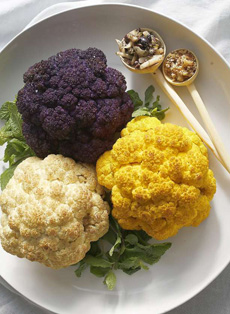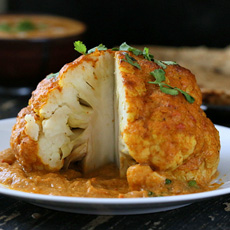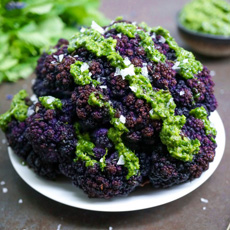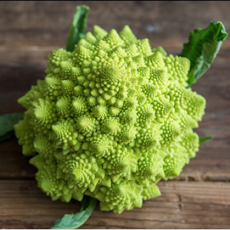Whole Roasted Cauliflower Recipe
|
Yesterday, Meatless Monday, we went one step beyond the meaty cauliflower steaks and cabbage steaks we’ve become so fond of. We remembered a recipe from Frieda’s Specialty Produce that we had tucked away in anticipation of the glorious fall cauliflower harvest. We love farmers market cauliflower. Not only is it fresher, but you can find the splendid colors of purple, orange, and pale green, as well as the exotic-looking, lime green romanesco (bottom photo). Whatever you choose, look for a dense head with a thick center stem. Roasting a whole cauliflower is simple; you just have to allow 90 minutes for it to roast. To see just how easy it is, check out this video from Frieda’s. “The crispy, nutty crust and sweet, tender core are the stuff dreams are made of,” they aver (and we agree). Ingredients 1. PREHEAT the oven to 375°F. Place the cauliflower on a plate and drizzle with olive oil and lemon juice, using your hands to coat the cauliflower all over. 2. SEASON all over with salt and transfer the cauliflower to a small roasting pan or cast-iron skillet, floret-side up. Cover tightly with aluminum foil. 3. BAKE for 30 minutes; remove the foil and roast for 1 hour until the florets are golden (larger heads can take longer). Transfer to a serving platter and serve immediately. 4. SLICE as desired: in wedges (our preference) or vertical, in 3/4- to 1-inch slices. You can also cut the cauliflower into individual florets, but why spend the time? Use your favorite international flavors as seasonings and sauces. Here are some simple replacements: The plant genus of cruciferous vegetables, Brassica, contains nutritional powerhouses that are packed with potent, cancer-fighting phytonutrients (antioxidants). It’s easy to eat a cup or more daily from the long list below. |
 [1] A tricolor roasted cauliflower feast. Here’s the recipe, which includes garlic breadcrumbs and fennel-olive relish (photo © San Francisco Chronicle).
|
|
|
There are more than 30 wild species of Brassica, plus numerous cultivars* and hybrids of cultivated origin. The best-known Brassica members include: |
||





